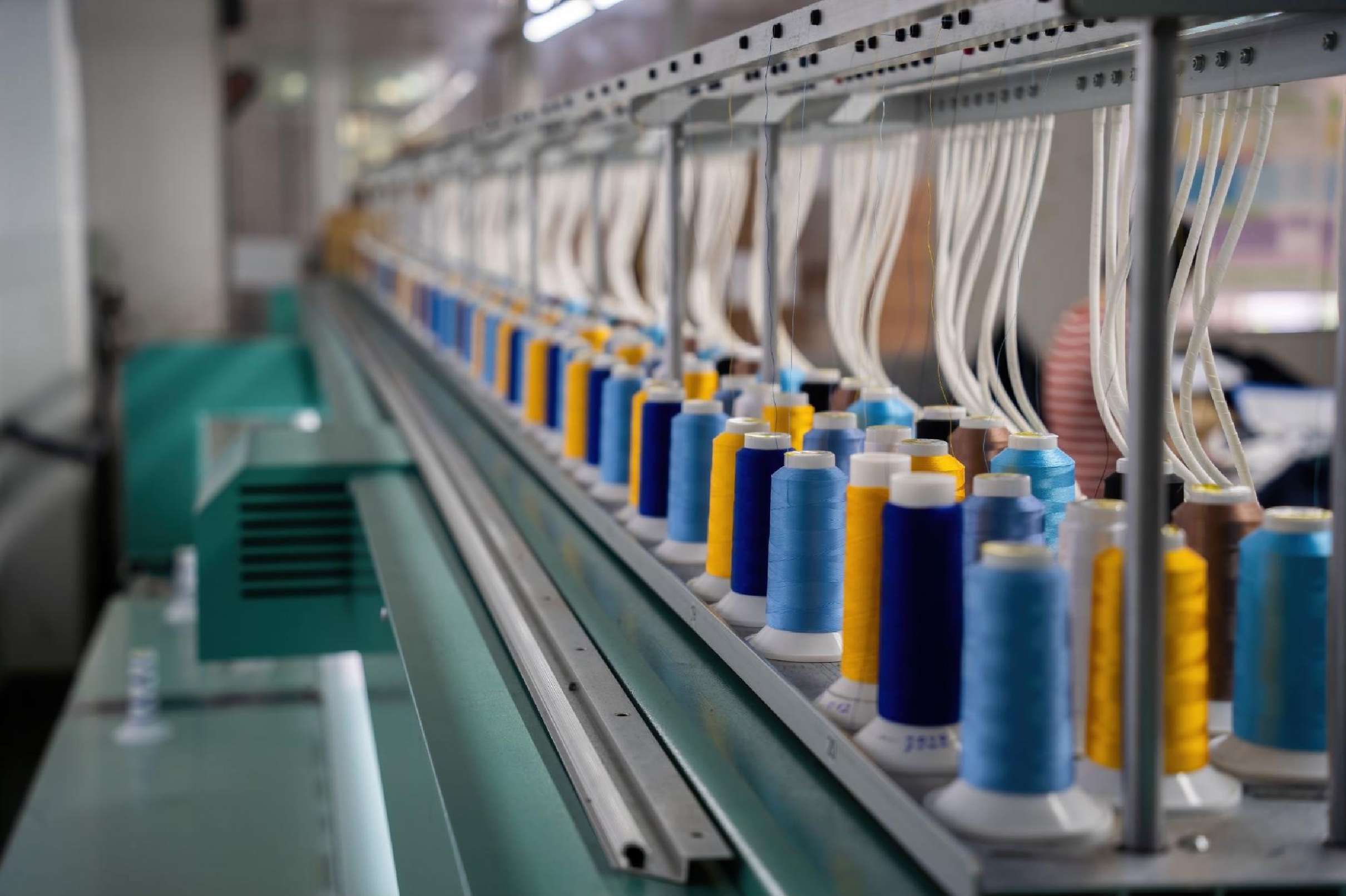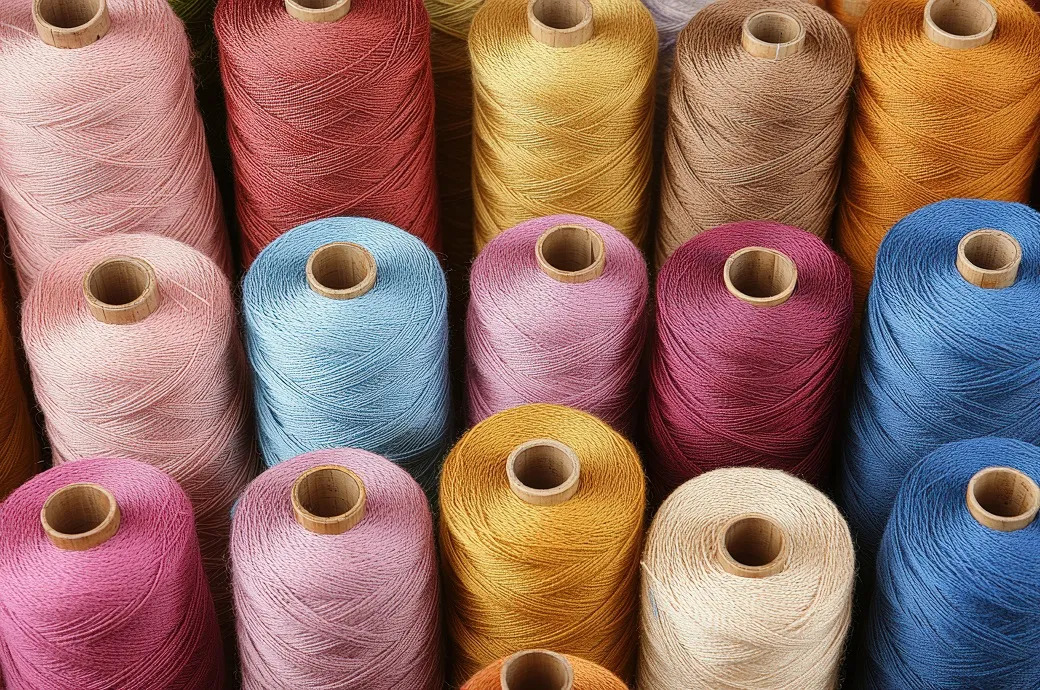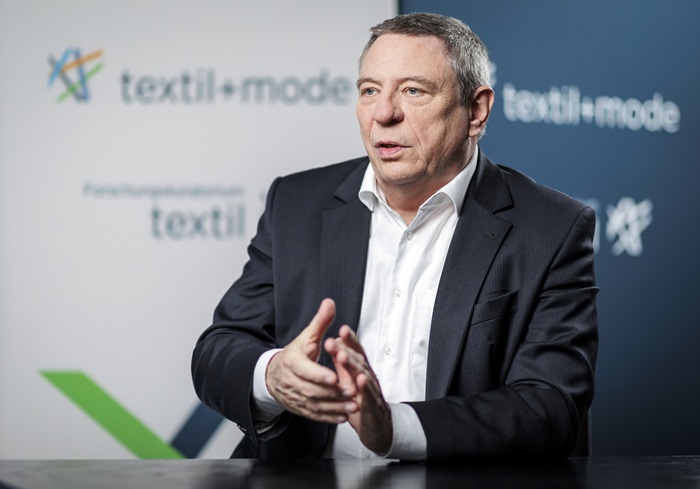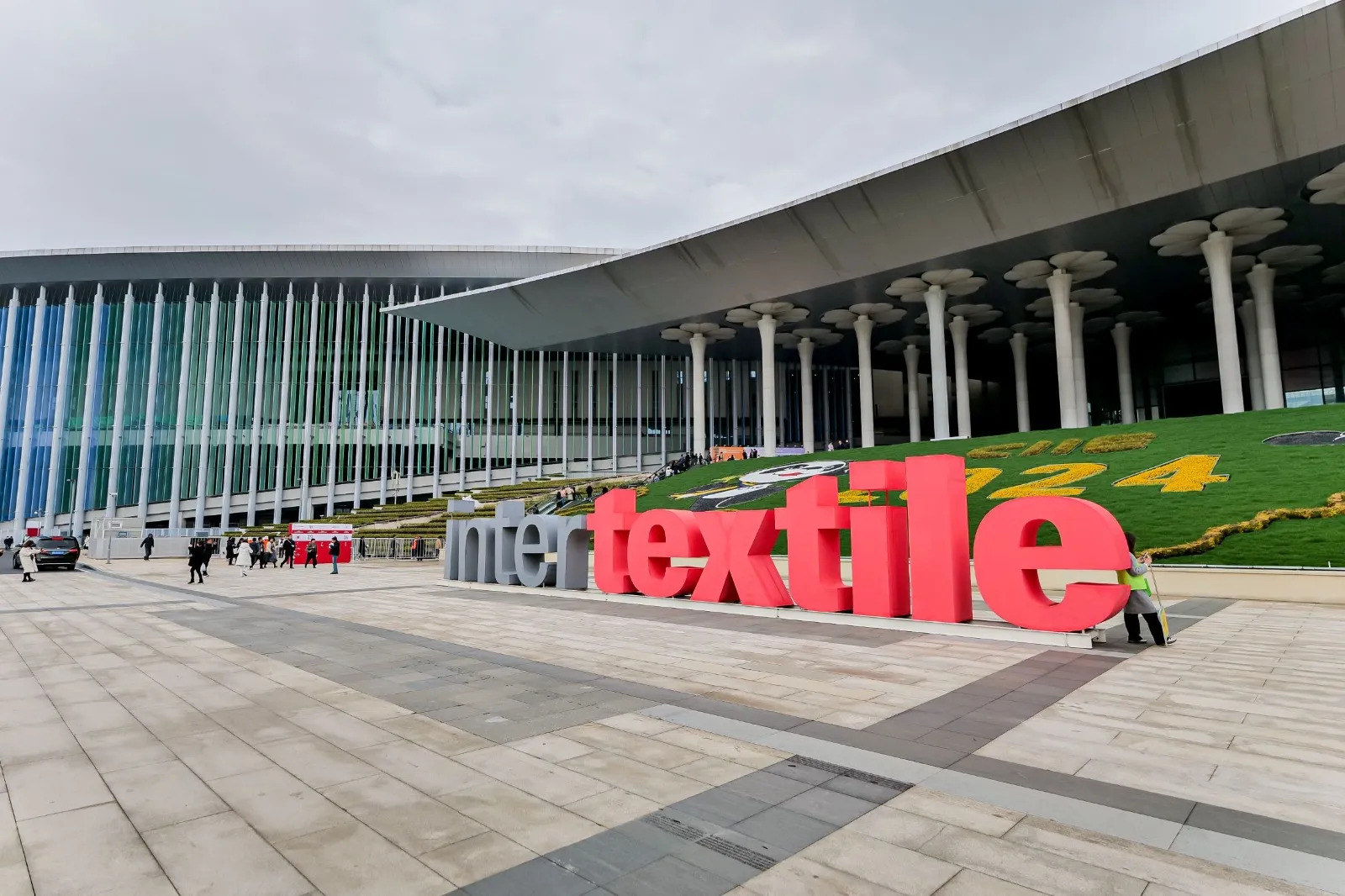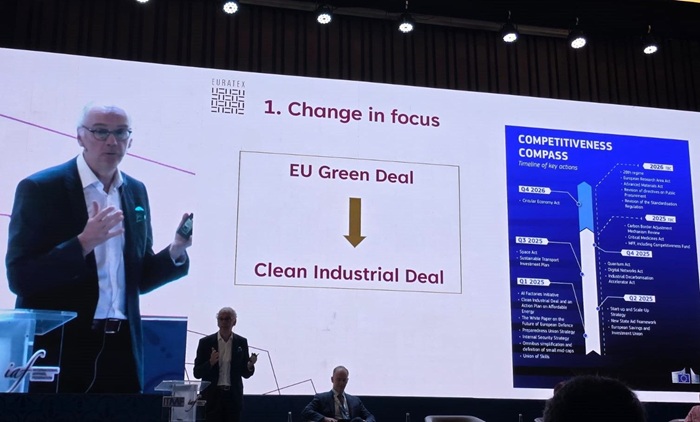FW
Led by Ranjan Mahtani, Executive Chairman, Epic Group, and Vijay Agarwal, Chairman, Creative Group along with Vishwanshu and Arunanshu Agarwal, have formally entered into a strategic joint venture to establish a new entity named Spectra.
Beginning with an MoU signed on January 9, 2025, this collaboration has progressed with the signing of a shareholder agreement and an initial investment of $15 million. The long-term objective of this venture is to achieve a scale of Rs 500 crore.
Spectra's first announced project is set to be India's largest sustainable denim and bottoms facility. This initial undertaking has the potential to revolutionize the Indian denim and bottoms industry and become one of the country's largest operations of its kind, featuring a top-tier production facility capable of manufacturing 700,000 pieces per month.
According to the companies, the new facility will be powered by renewable energy, create employment for 3,000 people in phase one (expanding to over 10,000), drive innovation, and establish new benchmarks in denim manufacturing. The venture is also committed to community development and sustainable growth.
A producer of recycled cotton fiber blends, Recover is teaming up with TextileGenesis, a software-as-a-service (SaaS) product from the technology company Lectra, on a new traceability project. The collaboration aims to verify the potential of Recover's circularity capabilities, helping retailers and brands track recycled materials throughout their lifecycle.
The pilot project will utilize TextileGenesis's Fibercoin Tool to create a digital twin of an asset - like textiles, clothing, or fibers - to track its journey along the value chain. For this initiative,
TextileGenesis generated a token for every kilogram of Recover material using Fibercoin. The organizations will employ two distinct methods to verify product traceability across various supply chain systems.
Upon completion of this trial, TextileGenesis and Recover plan to scale up the technology for broader fiber-to-garment traceability across different retail supply chain applications. The core idea is to track material input from its origin all the way to the retail storefront to enable businesses to more easily verify their circularity and recycling claims.
According to Orsolya Janossy, Senior Sustainability Manager, Recover, this initiative will be particularly critical for companies operating within the European Union due to upcoming legislation.
While Recover currently uses physical tracers for its materials, this partnership with TextileGenesis is expected to significantly enhance supply chain transparency for retailers and brands, strengthening the validation of circular claims. Amit Gautam, Founder and CEO, TextileGenesis, expressed confidence in his company's ability to undertake this responsibility with Recover.
Manufacturer of synthetic blended, cotton, and texturized yarn, fabrics, denim, and seamless garments, Sangam India has signed a non-binding MoU with Damensch Apparel, a specialist in apparel and lifestyle products. This strategic collaboration aims to explore a long-term partnership focused on the manufacturing, marketing, and sale of seamless and activewear products by Sangam India.
As part of the MoU, Sangam India will invest approximately Rs 99,929,050 to acquire a 1.73 per cent stake in Damensch on a fully diluted basis. This move comes as Sangam India’s consolidated net profit declined by 30.3 per cent to Rs 9.52 crore in Q4, FY25 despite a 4.7 per cent increase in net sales to Rs 734.30 crore.

India’s textile and apparel sector showed mixed results in FY25, with growth momentum visible in sales but profit metrics showing a more restrained pace. Insights from the latest Wazir Textile Index (WTI) and Wazir Apparel Index (WAI) reflect the industry's post-pandemic recalibration, grappling with input cost pressures and demand realignments.
Textile sector sees modest uptick, margin pressures persist
The Wazir Textile Index (WTI) for FY25 indicates a stable yet cautious revival. The WTI sales index saw a 7 per cent rise over FY24, and the EBITDA index also improved by 6 per cent, highlighting moderate recovery across major players. However, while the consolidated sales of leading textile firms which included Vardhman Textiles, Welspun Living, Arvind, Trident Group, Filatex India, RSWM KPR Mill, Indorama Synthetics, Indo Count and Nahar Spinning Mills rose by 6 per cent, EBITDA margins remained stagnant, indicating that profitability hasn’t kept pace with revenue growth.
Quarterly trends further underscore this margin stress. In Q4 FY25, the consolidated sales of top textile companies grew by 5 per cent year-on-year. But a notable decline in EBITDA margin—down by 0.4 percentage points—signaled continued pressure from rising operational costs and possibly subdued pricing power in global markets.
Apparel sector grows in volume, slips in profits
The apparel sector showed a contrasting picture, with good sales growth overshadowed by weak margins. According to the Wazir Apparel Index (WAI), FY25 recorded a 22 per cent increase in the sales index, while the EBITDA index dipped by 3 per cent, reflecting rising costs or tighter pricing strategies. The consolidated sales of select top apparel companies the list includes PDS, Pearl Global Industries, Gokaldas Exports, SP Apparels and Kitex Garments, jumped by 23 per cent year-on-year, but EBITDA margins slid by 0.2 percentage points.
The fourth quarter of FY25, however, brought some reprieve. Sales of leading apparel companies rose by 17 per cent compared to Q4 FY24, and the EBITDA margin improved slightly by 0.2 percentage points. This marginal recovery may be linked to easing input costs, better inventory management, or stronger demand in domestic and select export markets.
Revenue recovery meets margin caution
When viewed holistically, the consolidated performance of all listed textile and apparel companies in FY25 reflects a growth narrative tempered by cost pressures. Total consolidated sales across the sector rose by 8 per cent over FY24, a sign of demand stabilization and potentially improved export orders. However, consolidated EBITDA across these firms dropped by 0.5 percentage points. This reflects a challenge in maintaining profits amidst volatile raw material prices and shifting consumer preferences.
Cautious optimism amid structural realignments
The divergent performance between the textile and apparel segments suggests that while the value chain is bouncing back in terms of volume, cost containment and profitability optimization remain critical challenges. Going forward, sustained demand—both domestic and international—alongside softening cotton prices and greater efficiency in production processes, will be key to supporting EBITDA recovery.
Overall, FY25 has been a year of consolidation and cautious optimism for India’s textile and apparel sector. As global supply chains continue to rebalance, the industry’s ability to navigate cost volatility while scaling up value-added product offerings will determine its growth path in FY26 and beyond.
A global leader in home textiles, Welspun Living registered a 9.71% decline in its consolidated net profit to Rs 131.82 crore in Q4, FY25 compared to Rs 146 crore in Q4 FY24.
Despite this, the company’s revenue increased by 2.74 per cent Y-o-Y to Rs 2,645.90 crore for the period.
EBITDA for the quarter declined to Rs 318 crore, from Rs 400 crore in the same period last year, leading to a reduction in EBITDA margin from 15.3 per cent to 12 per cent.
The company’s Home Textile division reported a 1.27 per cent Y-o-Y rise in revenue to Rs 2,452.56 crore. Conversely, the Flooring business experienced an 8.05 per cent decline, recording revenues of Rs 195.76 crore in Q4 FY25.
For the full fiscal year 2025, Welspun Living's net profit decreased by 6.15 per cent to Rs 639.16 crore. However, its net sales rose by 8.94 per cent to Rs 10,545.09 crore compared to FY24.
Emphasizing on Welspun’s resilience and innovative approach in navigating these challenges, BK Goenka, Chairman, Welspun Group, stated, the company has a remarkable ability to turn disruption into opportunity. FY25 was a landmark year for the company as Welspun Living surpassed the Rs 10,000 crore revenue mark, with consolidated revenues reaching Rs 10,697 crore, representing 8.9 per cent growth. The company’s home textile exports also grew by 10.8 per cent.
Highlighting the success of emerging businesses, Goenka said, these contribute approximately 30 per cent of total revenues, underscoring the strength of their diversified model. The company's domestic consumer business grew by 5.1 per cent in FY25, with the Welspun brand expanding its household penetration and Spaces evolving into a comprehensive home lifestyle offering. International luxury brand Christy continues its profitable growth and market expansion beyond the UK.
Reinforcing its commitment to sustainability, Welspun Living achieved an impressive score of 83 in the 2024 S&P Global CSA ranking, positioning it as 1st in India and 4th globally in the Textile, Apparel & Luxury Goods category.
With its global distribution network spanning over 60 countries and world-class manufacturing in India, Welspun Living,remains a key strategic partner for top global retailers. The company's strategy is driven by branding, innovation, and sustainability. The company formally changed its name from Welspun India to Welspun Living on September 22, 2023.
The Istanbul Apparel Exporters Association (IHKIB) has signed a strategic Cooperation Protocol with Bilişim Vadisi (Informatics Valley), Turkiye’s leading technology development zone, to enhance the global competitiveness of the country’s apparel sector. The collaboration aims to advance twin transformation, sustainability, circular economy, and design innovation through targeted projects and work packages.
IHKIB Vice President Mustafa Paşahan highlighted Turkiye’s position as the world’s seventh-largest apparel exporter and the third-largest supplier to the EU, accounting for 3.2 per cent of global apparel exports. He emphasized Turkiye’s strengths in high-quality, flexible production and geographical advantage, along with compliance with EU standards in recycling, carbon reduction, digitalization, and social compliance.
IHKIB is already leveraging EU funding to drive transformation. The association has secured €37 million through IPA (Instrument for Pre-accession Assistance) programs. Key initiatives include the Metamorphosis project, which led to the creation of the Digital Transformation Center, and the newly launched Midas project supporting SMEs in their digital and green transition. A 'Carbon Footprint Tracking and Reduction' project is also set to begin this year.
Bilişim Vadisi General Manager Erkam Tuzgen underlined the importance of supporting next-generation textile innovations by connecting entrepreneurs, designers, and tech developers in one ecosystem.
Together, the two organizations will pursue national and international funding opportunities, support clustering in digitalization and design, and foster partnerships between startups and IHKIB members to drive sustainable and digital progress across Turkiye’s fashion industry.
Japan’s leading fashion technology innovator Shima Seiki Mfg, Ltd is set to participate in Graduate Fashion Week, taking place from 13-16 June 2025 in London, United Kingdom. As the world’s largest platform for emerging fashion talent, the event brings together graduates from over 80 fashion colleges and universities, providing a vital bridge between education and industry.
Shima Seiki will exhibit as part of the Digital Fashion Hub, a dedicated zone spotlighting cutting-edge fashion technologies. The company will showcase its subscription-based APEXFiz design software, aiming to drive awareness and adoption within undergraduate fashion curricula. With rising demand for skilled operators of its software, Shima Seiki is encouraging educational institutions to integrate APEXFiz into programs to better prepare students for careers in fashion design and manufacturing.
APEXFiz, based on the company's SDS-ONE APEX series, enables designers to plan, visualize, and simulate realistic textiles using 3D virtual sampling. It supports various techniques including flat and circular knitting, weaving, socks, and embroidery. By replacing the need for physical samples, the platform reduces waste, shortens lead times, and supports sustainability goals helping digitally transform the fashion production process.
Uniquely positioned as both a software and machinery manufacturer, Shima Seiki allows seamless data conversion from digital design to knitting machine programming, ensuring a smooth transition from concept to production.
Shima Seiki also extended congratulations to all participating graduates, expressing enthusiasm for their future impact on the global fashion industry.
Shrinking yields in the world's second-largest producer, India's cotton industry has prompted the Indian government to launch the National Cotton Productivity Mission, a comprehensive strategy focusing on crop diversification, significant yield improvement, introducing new, high-quality seed varieties, and promoting mechanized farming practices. These measures aim to revitalize India's cotton economy, which has been impacted by inconsistent yields.
According to the agriculture ministry, India's cotton output has steadily declined, from approximately 33.7 million bales in FY23 to an estimated 30.7 million bales in FY25. Moreover, India's cotton yield, around 465 kg per hectare in FY25, is significantly lower than China's average of over 2,170 kg/ha. China is currently the world's largest cotton producer, accounting for 26 per cent of global production, while India holds the second spot with 21 per cent.
As part of this five-year mission, the textiles ministry, in collaboration with the agriculture ministry, is consulting with experts, farmer groups, and state governments. Its aim is to double the yield from 465 kg/ha to 1,000 kg/ha across 11 major cotton-growing states like Maharashtra, Gujarat, Telangana, and Andhra Pradesh.
The declining yields have directly impacted cotton prices, which have risen from Rs 7,100-7,500 per quintal in 2024 to Rs 7,600-7,900. This price surge is making operations unviable for spinning mills, with some already curtailing operations.
Emphasizing on the urgency to improve export-led growth, Prabhu Dhamodharan, Convenor, Indian Texpreneurs Federation, says, with 60-65 per cent of India's apparel exports being cotton-based, higher domestic cotton prices, driven by poor yields and increased minimum support prices, are making Indian cotton less competitive globally. Yield improvement is the ‘only sustainable way forward,’ he asserts.
While India's cotton yarn exports rose to $12.04 billion in FY25, cotton imports also increased, to 2.15 million bales during October-March FY25. The National Cotton Productivity Mission is in its early stages, with further consultations planned.
Owner of its namesake popular Japanese lifestyle brand, Human Made Inc has successfully implemented Centric PLM (Product Lifecycle Management), a solution from Centric Software to significantly enhance the company's operational efficiency and boost its ongoing brand expansion efforts.
Established in 2010 by founder Nigo, Human MDE operates under the compelling theme, ‘The Future Is In The Past.’ Inspired by Nigo’s extensive vintage archive, the brand blends classic American casual fashion with diverse elements from workwear, military, sports, and outdoor styles.
After evaluating several product lifecycle management systems, Human Made ultimately chose Centric PLM. Their decision was based on the software's specialized functionality tailored for the apparel industry and Centric Software's proven track record of successful global deployments. Centric PLM provides a robust set of tools designed to streamline critical product-related processes, including planning, design, sourcing, pricing, and sales. This integration fosters improved collaboration and greater operational transparency across the entire value chain.
With Centric PLM now fully integrated, Human Made anticipates notable improvements in its product development timelines and overall decision-making. These enhancements are expected to play a crucial role in driving the brand's long-term business growth.
Fabrice Canonge, President, Centric Software, says, the successful PLM rollout with Human Mde Inc had yielded impressive results to date. Centric Software aims to support the brand’s continued success and global growth.
Centric Software offers enterprise solutions that assist businesses across various sectors, including apparel, footwear, home décor, cosmetics, and consumer electronics, in achieving their digital transformation objectives.
On World Environment Day 2025, the Hong Kong Research Institute of Textiles and Apparel (HKRITA) launched the Green Innotextile Base (GIB) in Shanghai, marking a significant step in cross-regional green innovation. Established in collaboration with Pudong New Force Incubator and the Pudong-Hong Kong Institute for Technology Transfer and Innovation, the GIB was unveiled at the Innostech 2025 Shanghai-Hong Kong Seminar.
Located in the Yangtze River Delta, GIB will drive sustainable development, promote circular economy practices, and facilitate research on advanced textile and apparel materials. It also aims to integrate fashion with artificial intelligence, strengthening innovation in the textile sector.
The GIB aligns with national green goals while setting technical standards, providing certifications, and enabling faster adoption of new technologies. It will also support Hong Kong-based enterprises with market expansion and investment opportunities, promoting deeper industry collaboration.
HKRITA Chairman Teresa Yang noted that the platform will bridge industry, academia, and research, promoting smart manufacturing and embedding sustainable fashion into the textile value chain. GIB, she said, aims to balance economic growth with environmental responsibility.
Geng Zhongwei, Chairman of Pudong New Force Incubator, emphasized that the platform will offer AI-powered automation and value-added services to support startups and enhance incubation effectiveness.
Chan Yi Ngok of the Pudong-Hong Kong Institute highlighted GIB's role in driving talent development, global collaboration, and sustainable productivity in the region.
HKRITA also announced a partnership with NeoRita Sustainable Technologies (Shanghai) Ltd to develop vegan leather using bacterial cellulose, showcasing Hong Kong’s innovation in sustainable materials and creative industries.

